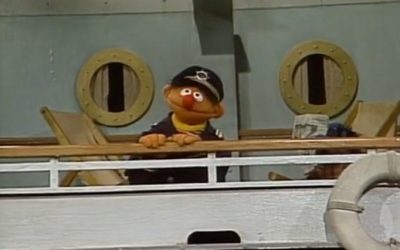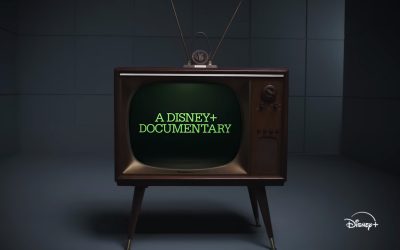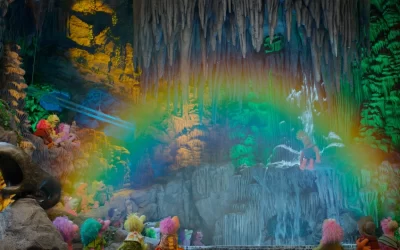Part 1 – Part 2
 Coming up after these messages is part two of our chat with “Street Gang” author Michael Davis! Be sure to click here and read part one, or else you’ll be horribly, irrevocably lost. Continuity is king!
Coming up after these messages is part two of our chat with “Street Gang” author Michael Davis! Be sure to click here and read part one, or else you’ll be horribly, irrevocably lost. Continuity is king!
And in case you haven’t been reminded enough, Michael will be appearing TONIGHT (that’s Friday, January 30 if you’re reading this late) with lots of famous Sesame Street alumni (including some folks by the names of Clash, Spinney, Manzano, McGrath, Robinson, Brill, Rudman, Geiss, and one Mr. Frank Oz) at William Patterson University in Wayne, New Jersey. Click here for more info, and if you’re already attending, be sure to say hi to the ToughPigs, who will be attending the heck outta this thing.
We now return you to your regularly scheduled interview.
ToughPigs: Aside from the interviews, what sort of research materials did Sesame Workshop provide you with for the book?
Michael Davis: A lot of tape. And you probably know, all of Sesame Workshop’s paper archives up until about 1976 are at the University of Maryland. Whatever I needed after that point, they tried to provide if it was still available. So if there was something specific that I wanted, I had to know exactly what to ask for. They didn’t give me the key to the filing cabinet. But to their great credit, whenever I had a question, it got answered. If I wanted a document or a letter, they found the letter. They were very professional about their assistance to me. And because Joan was interested in the project and gave it her blessing, they were doing Joan’s bidding. She’s the boss of bosses. Nobody wants to let her down. I can think of no time when I was turned down for anything.
It got a little sticky when it came to finding photographs for the book. Because as you know, they’re very interested in creating their own book, and needed to have a proprietary sense about holding on to some of those images, and I understood that. But their reluctance was actually a plus, because it forced me to think about what I could get for this book that they likely won’t go after. And the answer became evident to me, that we should ask the sources in the book if they would consider providing images from their personal collections. I had a wonderful photo researcher work with me named Vashti Anderson and between the two of us, appealing to sources in the book, we were able to get over 50 images which, I think have a real intimacy, a real kind of family feel to them. They’re pictures you would probably see framed in somebody’s house. Some people were a little reluctant. Loretta Long, a little. But God bless her, some of the images she gave us were the best of them all. We could have done a whole book of Bob McGrath images. He and his wife Ann have done a wonderful job of collecting personal mementos, archives, photographs. He had so much great stuff, it was such a hard choice to narrow it down. People were wonderful, and because they were so generous, it gave a very different feel to the collection of photographs. Originally we were just going to have 20, but when Viking saw what was coming in, they’re the ones that said “No, 50.”

TP: I mentioned in my review, my only complaint about the pictures was that I wanted more. If you got 20, I wanted 50. If you got 50, I wanted 500. Are you planning on making the images available elsewhere?
MD: Yes, StreetGangBook.com. To my regret, we didn’t end up using any pictures of Matt Robinson. I want to do something nice about Matt on the site, and soon, because I have a couple of great Holly Robinson Peete stories that I didn’t get to use. I wanted to create content on the website for people to come back to. I haven’t done a lot yet, but I wanted it to be a place where I can update content every once in a while and write some more about Sesame Street. There’s so much to write about, even the current stuff. I thought the season that just ended was just superb. I love the animated Bert and Ernie, I thought that was great. It’s presumptuous, but I think Jim would love it.
He was so techno-savvy. I don’t think Jim ever thought the characters were too precious. That’s why I did so much in the book about Burr Tilstrom. People ask me why I did so much; it’s because Burr created a very different model about how he felt about those characters. He didn’t want any commercialism at all. He didn’t want a Kukla and and Ollie in the stores. He felt that there was only one Kukla and one Ollie and those were the puppets on his hands. He felt that they had a soul and a life of their own. Jim didn’t, he kept the puppets in a plastic bag, he didn’t think that they were alive. He knew that the performers were the ones that gave them life. I’m not saying Burr Tilstrom was off his rocker, he just came about it from a different angle with a very different belief about these characters and what they represent. He could have been a gazillionaire. I’m old enough to remember Kukla, Fran and Ollie on television and they were it. They were it for a while. They could have been in every five and dime, every drug store, every toy store, but he didn’t want it. And then here you have Jim who went about it carefully, cautiously, but he was interested in making money from the characters. Why? Because it gave him the freedom to do the things he really wanted to do like the Dark Crystal and Labyrinth. He wanted to expand and make sure that the people who worked for him made a good wage. It’s two different ways of looking at the world. It’s so true to say that Burr Tilstrom influenced Jim in a profound way. We don’t know when it happened, but we do know that the light went on in Jim’s head about the way that these characters are represented through the lens of the camera and how they’re projected on the screen and how they have dimensionality and shape and form. One of the reasons he knew that was because of Kukla Fran and Ollie.

TP: Regarding Caroll Spinney’s reading of the audio book, did you have any influence in getting him? Was that your idea?
MD: ((Nods yes)) He was really up for it. Right from the start when I got the first call from Viking that Listen and Live bought the rights to the audio book, my first words were “I want Caroll Spinney to read this book.” If it can’t be me, I would want Caroll. I think my persistence helped. I said that if anybody is concerned about the hint of New England accent in his voice, get over it, because within five minutes it will melt away. I think the world of Caroll Spinney, and it was such a thrill to listen to him read the book. To be in the studio and to do that interview with him and to hear him read the words that I pecked out on my PC, it was an out-of-body experience. (Note: The audio book is also available on iTunes, where you can hear a sample of Caroll’s reading.)
TP: For people like me who bought the book in its first printing, if there will be extra chapters in future editions, will we get a chance to see them or will they be exclusive to those printings?
MD: I’m going to put everything up online. I have spoken to Viking about refreshing the book for its release to paperback and doing a chapter that updates the book and brings us right up to this year as the 40th anniversary approaches. I haven’t gotten anything that solidly promises that I can do that, but it’s something we’re discussing. I don’t want to ever make it like I’m trying to steal any thunder from the book that’s coming out this fall from Sesame Workshop, because they need their day in the sun too. If I’m allowed to, I’d really like to update the book because so much has happened and is happening. I think they’ve done some really interesting things in the last two seasons. I like Murray a lot and the Word On the Street idea. I realize that one of the great challenges of educating preschoolers and getting kids ready for school these days is their spoken vocabulary as well as their written vocabulary. Introducing kids to words now is so very important, and I admire what they’ve done for the show toward that end. I have no qualms whatsoever about Abby Cadabby. I think she’s adorable.
TP: I agree, I love Abby. And Leslie Carerra performs the hell out of her.
MD: She is magnificent. She’s hilarious, she’s adorable, she’s talented to the Nth degree. And they finally have their female star. I’ve read all of the contrary reviews about Abby and I don’t want to belittle it because I know it incurs the wrath of feminists that there’s this princess character in pink that reinforces what they believe is this kind of stereotype and an unfortunate target for young girls to reach for. But I’m old enough to see that everything in pop culture is a cycle, and we’re into that cycle of princesses again and little girls who desperately want to be in dresses and tutus.
It’s always a marriage of great writing and performance. If you didn’t have the great writing for Abby, she’d be shallow and a dud. But Abby grew out of the mind of the writing staff, Tony Geiss‘ brain, he’s the one who gave birth to Abby Cadabby. It didn’t come from the marketing department, it came the old fashioned way. Abby didn’t spring forth fully formed, she evolved and they played with her a bit. The first season was good, but the second season was better. That says to me that they’re wrapping their arms around this character, creating a real persona, a real personality with depth. I think she’s hilarious and I love the situations they create for her. They’ve got to stay in business, and the competing forces in the marketplace are profound. This is the golden age for preschool television. There’s great stuff on Nick, there’s great stuff on Disney, there’s great stuff on Discovery Kids. Sesame Street ain’t the only game in town anymore. They’ve got to fight, they’ve got to make themselves known, they’ve got to continue to move merchandise in the stores, and I’ll say that with my support. Because the money that comes in not only supports the domestic show, it helps to keep propagating the ideas of Sesame Street around the world, and I buy into those ideas. I think it’s very good, what they do, and unless somebody shows me an example of a degrading Sesame co-production that’s wrong-headed or promotes cultural stereotypes, I’m going to keep saying that it’s a good thing. It may be the very best ambassador that the United States has out there in the world, and I’m for it.

TP: Regarding Jon Stone’s memoir, is the Stone family actively trying to get it published? Because I’d love to read it.
MD: It’s my dearest hope that it will be published someday, and I’ve mentioned it to [Stone’s wife] Beverly and I’ve mentioned it to [their daughters] Polly and Kate, and I have offered my assistance to them if they want somebody to help edit the book and get it ready for an agent to look at or a publishing house to look at. I do think there is a long section of the book toward the back that has a little too much anger and vitriol in it. I don’t think anybody really wants to hear it. I think it was extremely cathartic for Jon to get it out of his system, but I don’t think anybody wants to read it. If you surgically removed that, what you have left is this magnificently funny, moving, poignant insider look at not only Sesame Street but the early days of television, and it really is such a window into his psyche, into the mind of this great creative person. He’s very tough on himself, he doesn’t project himself as this wonderful guy who has no flaws. To the contrary, he writes about his challenges, about getting along in the workplace, he doesn’t come across as this guy who had all of the answers all of the time. He does come off as somebody who really appreciated women, women in the workplace. He has wonderful things to say about Bob Keeshan and his term of service on Captain Kangaroo. I really hope the world gets to read the book some day because it’s that good. I feel privileged for having had the opportunity to read it and quote from it, and I thank the Stone family over and over again for allowing me to do so. It was a real extension of trust for them to allow me to do that, and I hope I did not let them down in any way.
TP: The story of the production of Sesame Street starts about halfway through “Street Gang”. With 40 years worth of production history to fit into about 200 pages, how did you choose what to cut?
MD: It was very hard. A smart person told me at the beginning of the project that I should have no more than seven major characters, so that helped me a little bit. I had to make decisions on what would keep the narrative moving. I also wanted to make sure that the people that I felt after doing the years of research who didn’t get as much credit, I wanted to make sure that the book would give them their due. So, Dulcy Singer. Lloyd Morrisett. Richard Hunt, I found his story to be so moving. I love his characters. Gladys, I love. I love Placido Flamingo and the Two-Headed Monster. His characters always spoke to me in a profound way. Oh, how could I leave this out? How could I leave out Sully and Biff? Genius, Sully and Biff.

TP: I don’t know any other character who could perform a silent character as well as Richard.
MD: And there’s a linkage there to Beaker. I really wanted to write more about that. I had a passage about Beaker and Stan Laurel, because I think they’re the same character in a lot of ways. And Beaker is genius.
TP:When we asked Steve Whitmire about performing Beaker, he said, “I can’t tell you exactly where that character came from, from within Richard, because I just don’t know.”
MD: My wife and I talk about this a lot, about the interior life of Beaker. We know his soft spots, we know what makes him happy, we know what makes him quizzical. It’s very hard for a puppet to do a comedic take, but Richard could do it. I talked to Caroll Spinney just the other day, and I asked him how he was able to make Oscar look chagrined and embarrassed when Sonia pulls him out of the can. Because he does, he shrinks. That’s just talent. These guys were master puppeteers. For all the things you can say about Frank and Jim, for all of Jim’s talents as a producer, director, performer and on and on, there was a point in our cultural history when he and Frank were the two best puppeteers anywhere. And if that was all they ever did, that would be enough. It’s very hard for me to watch Ernie and Bert’s “Have Yourself a Merry Little Christmas” duet in Christmas Eve on Sesame Street. It makes me so sad, I just couldn’t watch it this year. Because what it always brings me back to is that it can’t happen again.
 Special thanks to Michael Davis for taking the time to meet with us, and double special thanks for writing a book like “Street Gang”!
Special thanks to Michael Davis for taking the time to meet with us, and double special thanks for writing a book like “Street Gang”!
Click here to discuss this article on the ToughPigs forum!



